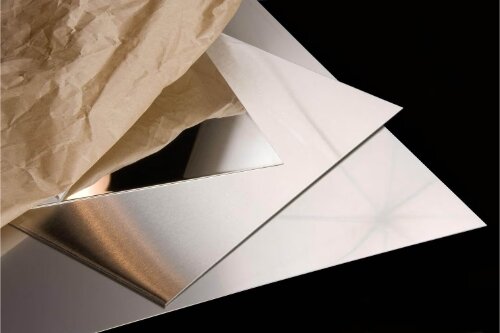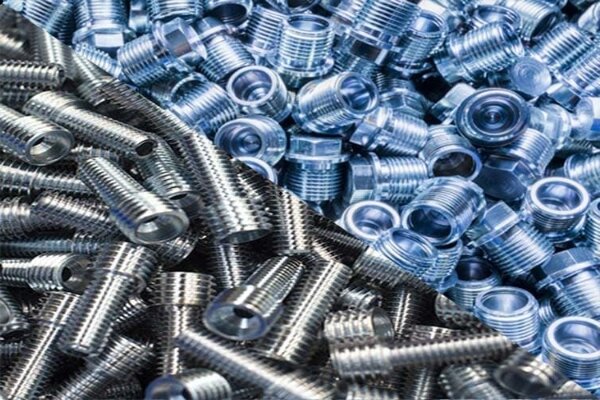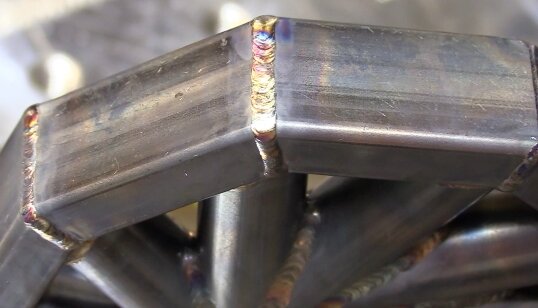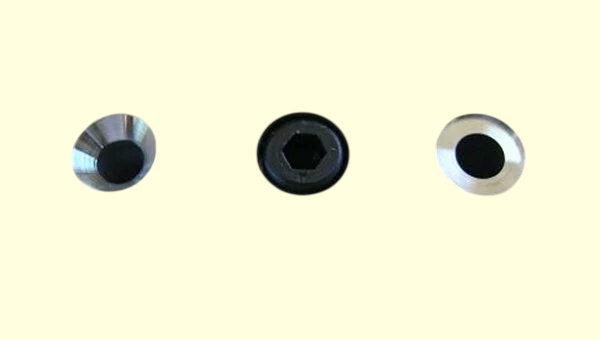O fabrico de peças metálicas complexas apresenta inúmeros desafios - desde a obtenção de tolerâncias apertadas até à garantia de uma qualidade consistente em todas as séries de produção. Muitos engenheiros e fabricantes debatem-se com a seleção de materiais e métodos de processamento que possam proporcionar precisão e durabilidade. A maquinagem CNC em aço inoxidável oferece uma solução comprovada para estes desafios.
Tem curiosidade em saber como este processo pode beneficiar a sua indústria? Continue a ler para explorar as técnicas, vantagens e aplicações da maquinagem CNC em aço inoxidável.
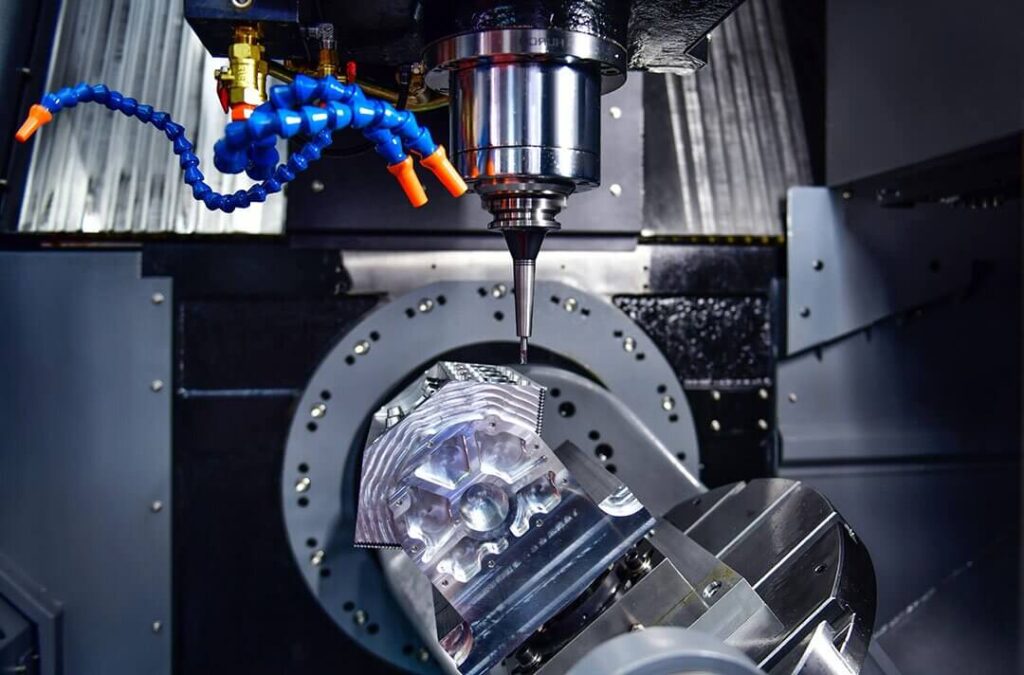
O que é a maquinagem CNC em aço inoxidável?
A maquinagem CNC de aço inoxidável envolve a utilização de maquinaria controlada por computador para cortar, moldar e terminar o aço inoxidável em componentes precisos. Técnicas como a fresagem, o torneamento e a perfuração permitem obter designs complexos e tolerâncias apertadas. O processo tira partido da resistência e versatilidade do aço inoxidável, ultrapassando desafios como o endurecimento por trabalho e a acumulação de calor.
Seleção do aço inoxidável adequado para maquinagem CNC
A escolha do tipo correto de aço inoxidável para maquinagem CNC é crucial para obter um desempenho, durabilidade e maquinabilidade ideais. Cada tipo oferece propriedades únicas adequadas a aplicações específicas, e compreender estas diferenças é fundamental para tomar uma decisão informada.
Diferenças entre vários tipos de aço inoxidável
Os aços inoxidáveis são classificados em diferentes graus com base na sua composição e propriedades:
- Aços inoxidáveis austeníticos (série 300): Conhecido pela sua excelente resistência à corrosão e maleabilidade. Os tipos mais comuns incluem:
- 304: Altamente versátil com boa maquinabilidade e resistência à corrosão, ideal para aplicações de uso geral como equipamento de processamento de alimentos e peças para automóveis.
- 316: Contém molibdénio para uma maior resistência à corrosão, tornando-o adequado para ambientes marinhos e químicos, mas ligeiramente mais difícil de maquinar do que o 304.
- 303: Melhoria da maquinabilidade devido à adição de enxofre, frequentemente utilizada para componentes de precisão como fixadores e engrenagens.
- Aços inoxidáveis martensíticos (série 400): Elevada força e resistência ao desgaste, mas menor resistência à corrosão. As qualidades como 416 são mais fáceis de maquinar devido à adição de enxofre.
- Aços inoxidáveis ferríticos (série 400): Oferecem boa resistência à corrosão e condutividade térmica com maquinabilidade mais fácil em comparação com os tipos austeníticos. São habitualmente utilizados em peças para automóveis.
- Aços inoxidáveis duplex: Combinam propriedades austeníticas e ferríticas, proporcionando elevada resistência e excelente resistência à corrosão, mas uma maquinabilidade difícil.
Seleção de aço inoxidável para aplicações específicas
A seleção do grau correto depende dos requisitos da aplicação:
- Resistência à corrosão: Para ambientes expostos a cloretos ou produtos químicos agressivos, as qualidades como o aço inoxidável 316 ou duplex são ideais devido ao seu teor de molibdénio.
- Maquinabilidade: Para projectos que exijam maquinação extensiva, é preferível o aço inoxidável 303 ou 416 devido à sua melhor maquinabilidade.
- Força e resistência ao desgaste: Os tipos martensíticos como o 440C são adequados para aplicações de alta resistência, como ferramentas ou rolamentos.
- Eficiência de custos: Para aplicações menos exigentes, o 304 oferece um equilíbrio entre desempenho e preço acessível.
O papel dos elementos de liga na maquinabilidade
Os elementos de liga influenciam significativamente a maquinabilidade do aço inoxidável:
- Enxofre: Melhora a maquinabilidade, reduzindo o atrito durante o corte, mas diminui ligeiramente a resistência à corrosão (por exemplo, em 303 e 416).
- Molibdénio: Aumenta a resistência à corrosão, mas aumenta o endurecimento por trabalho, tornando a maquinagem mais difícil (por exemplo, em 316).
- Níquel: Promove a ductilidade e a tenacidade, essenciais para as qualidades austeníticas como 304 e 316.
- Crómio: Proporciona resistência à corrosão através da formação de uma camada passiva de óxido; presente em todos os aços inoxidáveis com um mínimo de 10.5%.
- Carbono: Aumenta a resistência mas pode afetar a soldabilidade; as variantes com baixo teor de carbono, como o 304L, são utilizadas quando é necessário soldar.
Tipos de processos de maquinagem CNC para aço inoxidável
A maquinagem CNC oferece uma gama de processos adaptados para satisfazer as exigências dos componentes em aço inoxidável. Cada técnica foi concebida para lidar com a dureza do material, proporcionando precisão e eficiência.
Fresagem: Precisão e versatilidade
Fresagem utiliza ferramentas de corte rotativas para remover material de uma peça de trabalho estacionária, tornando-a ideal para a criação de formas complexas, ranhuras e sulcos. As fresadoras CNC são excelentes na produção de peças com tolerâncias apertadas e desenhos complexos.
Torneamento: Moldar com velocidade e precisão
Girando envolve a rotação da peça de trabalho enquanto uma ferramenta de corte estacionária a molda. Este processo é perfeito para componentes cilíndricos como veios, casquilhos e fixadores.
Perfuração: Chave para a criação de furos
Perfuração cria furos precisos em aço inoxidável para fins de montagem ou funcionais. As máquinas de perfuração CNC oferecem precisão e repetibilidade, mesmo para furos profundos ou angulares.
Retificação: Alcançar a perfeição do acabamento da superfície
Retificação é utilizada para obter acabamentos de superfície suaves ou remover pequenas quantidades de material para ajustes finos. É particularmente útil para polir ou rebarbar peças de aço inoxidável.
EDM: Maquinação por Descarga Eléctrica para cortes minuciosos
A maquinagem por descarga eléctrica (EDM) é um processo sem contacto que utiliza faíscas eléctricas para corroer o material. É ideal para criar cortes complexos e caraterísticas delicadas, ou para trabalhar em componentes de aço inoxidável endurecido.
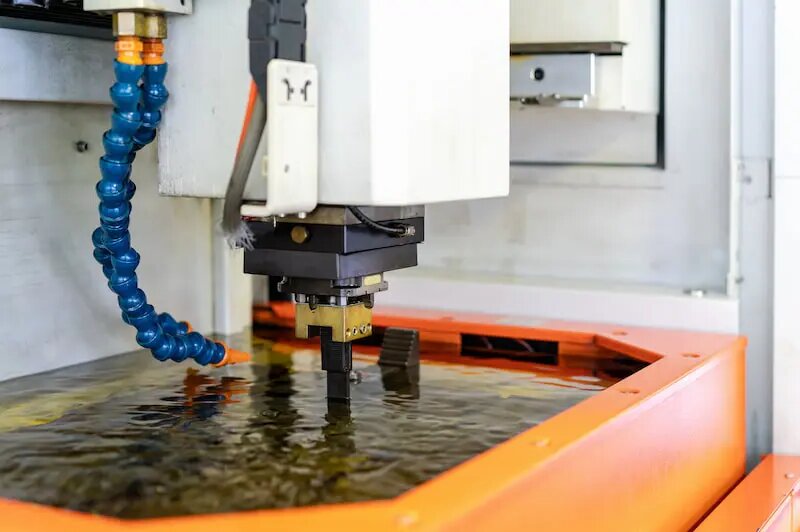
Benefícios da maquinagem CNC em aço inoxidável
A maquinagem CNC oferece várias vantagens quando se trabalha com aço inoxidável:
- Precisão e exatidão: Atinge tolerâncias apertadas (tão finas como 0,0002 polegadas), assegurando uma qualidade consistente em todas as peças.
- Durabilidade: A força e a resistência à corrosão do aço inoxidável tornam-no ideal para componentes de longa duração.
- Versatilidade: Adequado para geometrias complexas e desenhos personalizados em várias indústrias.
- Qualidade da superfície: Produz acabamentos suaves que melhoram a estética e a funcionalidade.
- Eficiência: Os processos automatizados reduzem o desperdício e o tempo de produção, mantendo uma elevada qualidade de produção.
Factores que afectam a maquinagem CNC em aço inoxidável
A maquinagem CNC de aço inoxidável é influenciada por vários factores que têm impacto na eficiência, precisão e longevidade da ferramenta. Compreender estes elementos é essencial para otimizar o processo de maquinagem e obter resultados de elevada qualidade.
Propriedades dos materiais e sua influência
As propriedades únicas do aço inoxidável, tais como a elevada resistência, a resistência à corrosão e as tendências de endurecimento por trabalho, tornam-no simultaneamente valioso e difícil de maquinar.
- Endurecimento do trabalho: O aço inoxidável endurece rapidamente durante o corte, aumentando o desgaste da ferramenta e a dificuldade de maquinagem.
- Condutividade térmica: A sua fraca condutividade térmica faz com que o calor se concentre na zona de corte, podendo deformar a peça de trabalho e reduzir a vida útil da ferramenta.
- Resistência: A elevada dureza pode dar origem a limalhas fibrosas que são difíceis de gerir, afectando o acabamento da superfície e o desempenho da ferramenta.
Escolher as ferramentas certas para o aço inoxidável
A seleção de ferramentas desempenha um papel fundamental na maquinação de aço inoxidável:
- Material: As ferramentas de metal duro com revestimentos como TiAlN ou AlTiN são preferidas pela sua resistência ao calor e durabilidade.
- Geometria: Os ângulos de inclinação positivos e as arestas afiadas reduzem as forças de corte e a produção de calor.
- Inserções especializadas: As ferramentas concebidas para aço inoxidável, tais como as que possuem quebra-cavacos, ajudam a gerir a evacuação dos mesmos e a evitar danos na ferramenta.
Considerações sobre desgaste e manutenção de ferramentas
O desgaste das ferramentas é um desafio significativo na maquinagem de aço inoxidável:
- Mecanismos de desgaste: Os problemas mais comuns incluem o desgaste do flanco, o desgaste da aresta e o desgaste do entalhe devido ao endurecimento por deformação e à acumulação de calor.
- Práticas de manutenção: A inspeção regular, a afiação e a utilização de líquidos de refrigeração podem prolongar a vida útil da ferramenta. Os sistemas de refrigeração de alta pressão são particularmente eficazes na gestão do calor e na melhoria do desempenho.
O impacto da calibração de máquinas na qualidade
A calibração correta da máquina assegura a precisão dimensional e resultados consistentes:
- Alinhamento de precisão: A calibração regular minimiza os desvios causados pelo desgaste ou pelo desalinhamento dos componentes da máquina.
- Controle de qualidade: As máquinas precisas reduzem os defeitos, as taxas de refugo e os custos de retrabalho, mantendo as tolerâncias rigorosas exigidas para as peças de aço inoxidável.
- Desempenho a longo prazo: A calibração prolonga a vida útil da máquina, evitando o esforço excessivo dos componentes devido a desalinhamentos ou definições incorrectas.
Aplicações da maquinagem CNC em aço inoxidável
A maquinagem CNC em aço inoxidável é indispensável nos sectores que exigem componentes robustos e precisos:
Aplicações da indústria aeroespacial e de defesa
Componentes principais:
- Peças para motores de turbina
- Elementos estruturais de aeronaves
- Sistemas de orientação de precisão
- Componentes do satélite
- Hardware do sistema de mísseis
Fabrico de dispositivos médicos
Aplicações primárias:
- Instrumentos cirúrgicos
- Componentes de dispositivos implantáveis
- Peças de equipamento de diagnóstico
- Ferragens resistentes à esterilização
- Mecanismos protéticos
Produção automóvel e de equipamento pesado
A indústria transformadora em foco:
- Componentes do motor
- Peças de transmissão
- Elementos do sistema de escape
- Mecanismos de suspensão
- Interfaces mecânicas de alta tensão
Eletrônicos e bens de consumo
Aplicações típicas:
- Molduras para smartphones
- Hardware informático
- Conectores de precisão
- Mecanismos da câmara
- Componentes de tecnologia vestível
Arquitetura e componentes estruturais
Cenários de utilização:
- Fachadas arquitectónicas
- Reforços estruturais
- Elementos decorativos
- Sistemas de revestimento exterior
- Infra-estruturas de suporte de carga
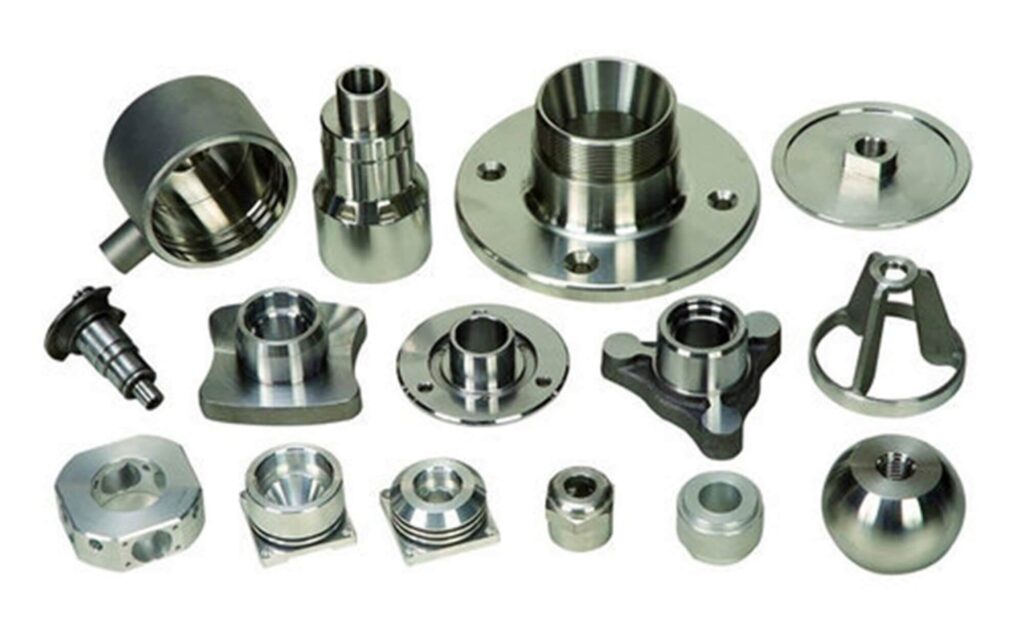
Técnicas para melhorar o desempenho da maquinagem
Melhorar o desempenho da maquinagem do aço inoxidável envolve a otimização dos principais parâmetros e estratégias para enfrentar desafios como a geração de calor, o desgaste da ferramenta e as propriedades do material. Abaixo encontram-se técnicas eficazes para melhorar a eficiência, a precisão e a vida útil da ferramenta.
Otimização da velocidade de corte e das taxas de avanço
A velocidade de corte e a taxa de avanço são fundamentais para equilibrar a produtividade e a longevidade da ferramenta:
- Velocidade de corte: As velocidades mais baixas reduzem a produção de calor e o desgaste da ferramenta, mas podem diminuir a produtividade. Para o aço inoxidável, as velocidades recomendadas variam entre 40-80 SFM, dependendo da classe e do material da ferramenta.
- Taxa de alimentação: Taxas de avanço mais elevadas podem melhorar as taxas de remoção de material e reduzir o calor, transportando-o em aparas maiores. No entanto, taxas de avanço excessivas podem comprometer o acabamento da superfície ou sobrecarregar a ferramenta.
Métodos de arrefecimento para maquinagem CNC em aço inoxidável
Um arrefecimento eficiente é essencial para gerir a acumulação de calor durante a maquinagem:
- Líquido de arrefecimento de inundação: Proporciona um arrefecimento e lubrificação eficazes, especialmente para operações a alta velocidade. Os refrigerantes à base de água com elevada lubricidade são preferidos para o aço inoxidável.
- Refrigerante de névoa: Adequado para aplicações em que o líquido de arrefecimento por inundação não é prático, oferecendo arrefecimento moderado e evacuação de aparas.
- Sistemas de refrigeração de alta pressão: Fornece líquido de refrigeração diretamente para a zona de corte para melhorar a dissipação de calor e a remoção de aparas.
- Maquinação a seco com jato de ar: Nalguns casos, os jactos de ar podem ser utilizados para limpar as aparas, mantendo as temperaturas estáveis, especialmente quando os riscos de choque térmico são elevados.
Gerir a produção de calor durante a maquinagem
O calor excessivo pode levar ao endurecimento do trabalho, ao desgaste da ferramenta e a imprecisões dimensionais:
- Geometria da ferramenta: Utilizar ferramentas com ângulos de inclinação positivos para reduzir as forças de corte e a produção de calor.
- Profundidades de corte: Utilizar profundidades radiais de corte mais pequenas para minimizar o aquecimento localizado, mantendo a produtividade com profundidades axiais de corte mais elevadas (por exemplo, fresagem de alta eficiência).
- Percursos de ferramenta adaptáveis: Técnicas como a fresagem trocoidal ou escalada distribuem o calor de forma mais uniforme pela aresta de corte, reduzindo a tensão localizada.
- Aplicação do líquido de refrigeração: Assegurar um fornecimento consistente de líquido de refrigeração à zona de corte para evitar o sobreaquecimento.
Minimizar o desgaste da ferramenta e prolongar a sua vida útil
O desgaste da ferramenta é um fator significativo que afecta o desempenho da maquinagem:
- Materiais e revestimentos para ferramentas: Utilize ferramentas de metal duro com revestimentos como TiAlN ou TiCN para aumentar a resistência ao desgaste e a dissipação de calor.
- Manutenção regular: Inspecionar frequentemente as ferramentas para detetar sinais de desgaste, tais como desgaste do flanco ou do entalhe.
- Gestão de chips: A evacuação eficiente de aparas evita o recorte de aparas, o que pode embotar as ferramentas prematuramente.
- Forças de corte inferiores: Evitar os parâmetros de corte agressivos que exercem uma tensão excessiva sobre as ferramentas.
Conclusão
A maquinagem CNC em aço inoxidável é um processo vital no fabrico moderno, oferecendo precisão, durabilidade e versatilidade em várias indústrias. Ao compreender as propriedades únicas do aço inoxidável e ao empregar técnicas eficazes, os fabricantes podem obter resultados de alta qualidade.
Ao considerar o seu próximo projeto que envolve componentes em aço inoxidável, lembre-se da importância de selecionar as técnicas e ferramentas corretas para garantir uma eficiência e precisão ideais. Se estiver à procura de orientação especializada ou se tiver necessidades específicas de maquinagem, não hesite em estender a mão!
Olá, chamo-me Kevin Lee

Nos últimos 10 anos, tenho estado imerso em várias formas de fabrico de chapas metálicas, partilhando aqui ideias interessantes a partir das minhas experiências em diversas oficinas.
Entrar em contacto

Kevin Lee
Tenho mais de dez anos de experiência profissional no fabrico de chapas metálicas, especializando-me em corte a laser, dobragem, soldadura e técnicas de tratamento de superfícies. Como Diretor Técnico da Shengen, estou empenhado em resolver desafios complexos de fabrico e em promover a inovação e a qualidade em cada projeto.

